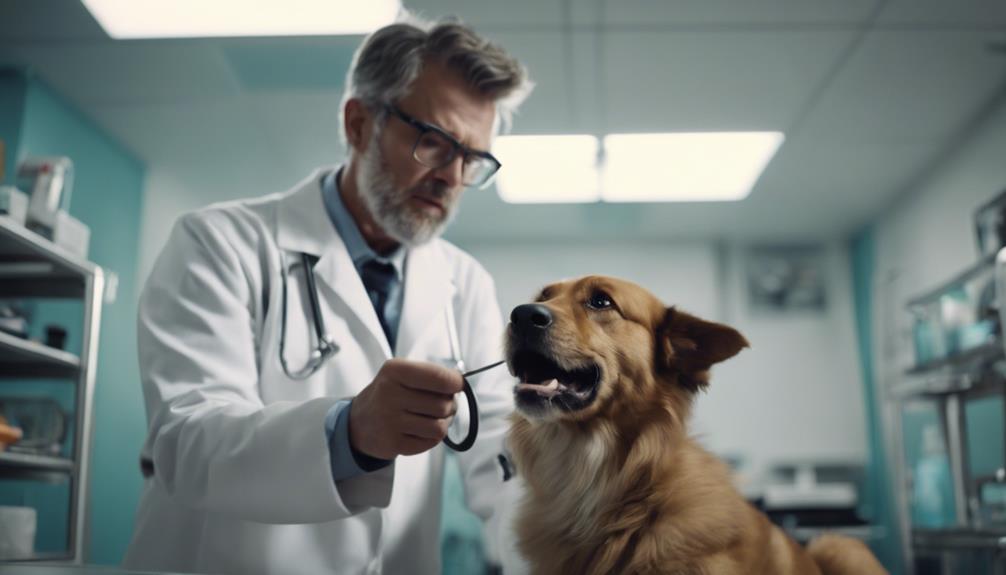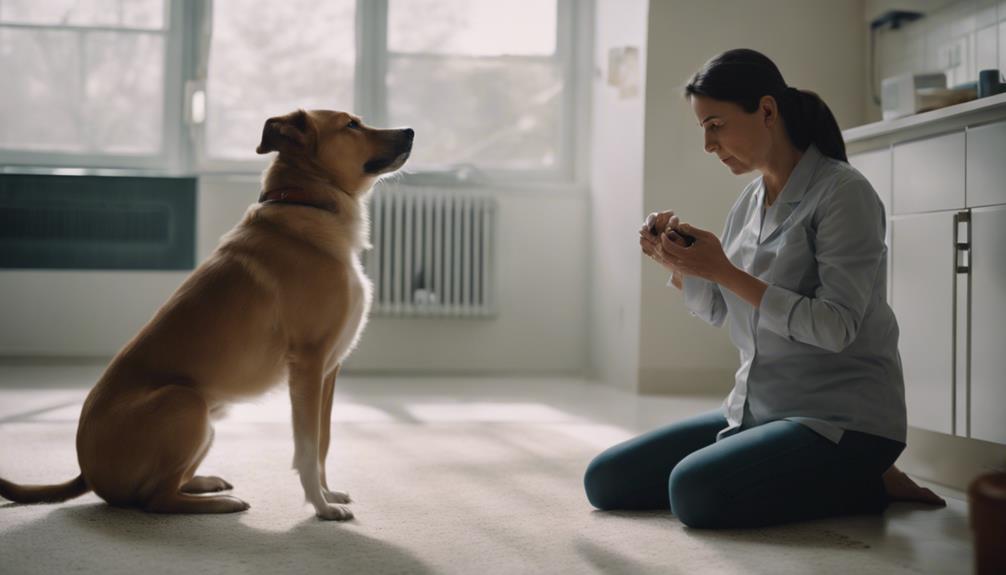Umbilical hernias in dogs raise a pertinent question for responsible pet owners – should these hernias be cause for concern?
While this condition is common, the implications can vary significantly. Understanding the potential risks and consequences associated with untreated umbilical hernias is crucial for informed decision-making regarding your dog's health.
Stay tuned as we navigate through the intricacies of umbilical hernias in dogs, shedding light on the significance of early detection and appropriate management strategies to ensure your canine companion's well-being.
Key Takeaways
- Umbilical hernias in dogs can be concerning if they are large or show signs of trapped intestines.
- Prompt veterinary attention is crucial for diagnosis and appropriate treatment.
- Surgery may be necessary for larger hernias to prevent complications.
- Monitoring the umbilical area in puppies and seeking help for any worrying signs can help prevent issues.
Importance of Recognizing Umbilical Hernias
Why is it crucial to promptly recognize umbilical hernias in dogs to ensure their health and well-being?
Umbilical hernias, though often harmless, can lead to serious complications if left untreated. Prompt recognition allows for timely intervention, reducing the risk of complications such as trapped intestines, pain, and discomfort.
By identifying umbilical hernias early on, veterinarians can assess the size and severity of the hernia, determining the appropriate course of action. Small hernias may resolve on their own, but larger hernias often require surgical intervention to prevent further issues.
Understanding the importance of recognizing umbilical hernias in dogs is essential for maintaining their health and ensuring a high quality of life.
Signs and Symptoms to Watch For
Recognizing umbilical hernias in dogs requires vigilance for specific signs and symptoms that indicate the presence of this condition. Watch for a small opening at the umbilicus site, typically larger than the end of a pinkie finger.
Hernias that are concerning may show signs of bubbling out or be larger than a pinkie finger. Additionally, be alert for symptoms such as pain, stiffness, and vomiting, which could indicate trapped intestines.
Monitoring the umbilical area during puppyhood is crucial in catching these signs early. Seek prompt veterinary attention if you notice any worrisome symptoms to ensure timely diagnosis and appropriate treatment of umbilical hernias in dogs.
Why Prompt Diagnosis Is Crucial
Timely and accurate diagnosis of umbilical hernias in dogs is imperative for ensuring effective treatment and preventing potential complications. Prompt diagnosis is crucial for the following reasons:
- Preventing Intestinal Strangulation: Rapid diagnosis can help identify hernias at risk of trapping intestines, requiring immediate surgical intervention.
- Avoiding Pain and Discomfort: Early detection ensures timely management, reducing the risk of pain, discomfort, and potential distress for the dog.
- Enhancing Treatment Success: A swift diagnosis allows for timely surgical correction, increasing the likelihood of successful outcomes and minimizing the chances of complications associated with untreated hernias.
Treatment Options for Hernias
Early diagnosis of umbilical hernias in dogs is crucial as it directly impacts the available treatment options for this condition. Treatment varies depending on the size and severity of the hernia. Small hernias might resolve on their own, while larger ones often require surgical intervention to prevent complications. Emergency surgery becomes necessary if the intestines become trapped. In some cases, surgery can be combined with spaying/neutering for cost efficiency.
| Treatment Options for Hernias | |
|---|---|
| Small Hernias | May resolve on their own |
| Large Hernias | Surgical intervention to prevent complications |
| Emergency Cases | Immediate surgery if intestines are trapped |
Surgical Intervention for Severe Cases
In cases of significant umbilical hernias in dogs, surgical intervention is often necessary to address the condition effectively and prevent potential complications. Surgical procedures for severe cases of umbilical hernias involve repairing the abdominal wall defect and securing the protruding tissues back into place.
Here are three key points to consider regarding surgical intervention for severe cases of umbilical hernias in dogs:
- Procedure Complexity: The surgical repair for large or complicated hernias may require more advanced techniques and longer recovery times.
- Postoperative Care: Proper postoperative care, including monitoring for signs of infection or hernia recurrence, is crucial for a successful outcome.
- Consultation with a Veterinary Surgeon: Seeking consultation with a veterinary surgeon experienced in hernia repair can ensure the best possible treatment for the dog.
Preventive Measures for Dog Owners
For dog owners looking to safeguard their canine companions from the risks associated with umbilical hernias, implementing proactive preventive measures is paramount. Keeping a close eye on the umbilical area during puppyhood is crucial. Regular monitoring can help detect any abnormalities early on, allowing for prompt veterinary attention if needed.
It is essential to be vigilant for any signs of a protruding umbilicus or a hernia larger than the end of a pinkie finger. Seeking immediate veterinary care for concerning signs can prevent complications and ensure appropriate management if an umbilical hernia is detected. By staying proactive and attentive, dog owners can play a significant role in maintaining their pet's health and well-being.
Understanding Umbilical Hernia Management

Effective management of umbilical hernias in dogs involves strategic interventions to address the condition promptly and minimize potential complications. When dealing with umbilical hernias in dogs, it is crucial to consider the following:
- Regular monitoring of the hernia size and any changes in the dog's behavior.
- Consultation with a veterinarian to determine the most appropriate treatment plan.
- Prompt surgical intervention for larger hernias or those causing symptoms like pain or vomiting.
Exploring Related Dog Health Articles
Exploring various facets of dog health beyond umbilical hernias provides a comprehensive understanding of canine well-being and potential health issues.
Belly Button Variations in Dogs can shed light on other abdominal abnormalities that may affect dogs.
Weight Management and Body Condition articles are crucial for maintaining overall health and preventing obesity-related issues.
Digestive Issues like Puppy Diarrhea highlight common gastrointestinal problems in dogs.
Eye Health articles such as Cataracts in Dogs emphasize the importance of ocular health and early detection of eye conditions.
Parasite Infestation articles focusing on Worms in Dog Poop underscore the significance of regular deworming and fecal examinations to prevent parasitic infections.
These related dog health topics contribute to a holistic approach in ensuring the well-being of our canine companions.
Further Topics on Dog Health

Delving into additional aspects of canine well-being, the following topics on dog health encompass various critical areas to aid in understanding and managing common health concerns in dogs.
- Encouraging Appetite in Puppies
- Labored Breathing in Dogs: Causes and Treatment
- Dealing with Parvo: Prevention and Treatment
These topics delve into crucial aspects of dog health. Encouraging appetite in puppies is essential for their growth and development. Labored breathing in dogs can indicate underlying health issues that require prompt attention. Understanding how to deal with Parvo, including prevention strategies and treatment options, is vital in safeguarding your dog's health.
Conclusion: Keeping Your Dog Healthy
As we conclude our exploration of various aspects of dog health, it is imperative to emphasize the importance of proactive measures in maintaining the well-being and longevity of your canine companion. Ensuring your dog's health involves a combination of proper nutrition, regular exercise, routine veterinary check-ups, and prompt attention to any concerning symptoms. Additionally, preventive measures such as vaccinations, parasite control, and dental care play crucial roles in keeping your dog healthy. Remember, early detection of health issues can lead to more successful treatment outcomes. Below is a table summarizing key components of maintaining your dog's health:
| Healthy Dog Practices | Description |
|---|---|
| Proper Nutrition | Balanced diet tailored to dog's needs |
| Regular Exercise | Daily physical activity for fitness |
| Routine Vet Check-ups | Scheduled visits for preventive care |
| Prompt Attention | Addressing any health concerns promptly |
| Preventive Measures | Vaccinations, parasite control, dental care |
Conclusion
In conclusion, recognizing and addressing umbilical hernias in dogs is essential for their overall health and well-being. By understanding the signs, symptoms, and treatment options available, pet owners can ensure timely intervention and appropriate care for their canine companions.
Vigilance and proactive management are key in managing this common health concern in dogs, ultimately contributing to their longevity and quality of life.




